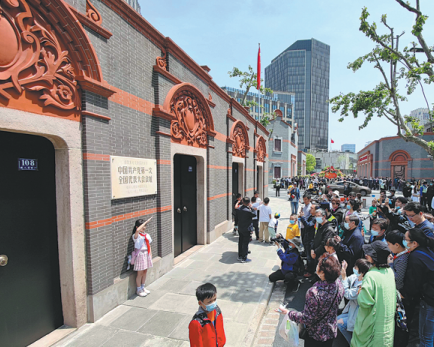Legislators call for law to protect Red culture
Some national lawmakers want legislation introduced to preserve China's Red cultural resources, which showcase a rich revolutionary spirit and tell profound stories about revolution and construction in the country in the century since the founding of the Communist Party of China.
The Red resources possess irreplaceable political and educational value as a record of the great practices of the Party and can continue to inspire and lead the young, they said.
Last year marked the centenary of the CPC's founding, and many Red cultural sites across the country were given face-lifts as part of celebrations. However, deputies to the National People's Congress, China's top legislature, said integrated development of such resources has been lacking, and some sites need to improve display methods to better engage the public.
Legislation could promote the coordinated, standardized and orderly development of such resources, said Chen Li, an NPC deputy from Shanghai.
"Through legislation, we can turn the Red tourism venues scattered all over the country into vivid classrooms that continue to inspire the public and allow individuals to absorb profound political wisdom, obtain moral nourishment and enhance cultural confidence," said Chen, who is also general manager of Shanghai Mobile, a mobile network operator.
He said the venues will also become valuable economic resources when Red culture, related relics and the surrounding environment are well integrated.
People made 700 million trips to Red tourism sites in 2019, accounting for more than 11 percent of domestic trips, according to the China Tourism Academy.
Chen suggested the law could cover the preservation of both tangible heritage-former residences, cemeteries, relics and documents-and also intangible stories and slogans.
"Also, the law should encourage and support such Red resources being open to the public for free," he said.
"Retired officials, veterans, experts, scholars and students shall be encouraged by the law to serve regularly as volunteer narrators at the venues, and in particular on important days, including the annual celebrations to commemorate the Party's founding and the founding of New China."
More than 10 cities, including Baise, Guangxi Zhuang autonomous region, Jiaxing, Zhejiang province, Huanggang, Hubei province, and Bazhong, Sichuan province, have released local laws concerning the preservation of Red resources.
The Regulations of Shanghai on the Inheritance, Promotion, Preservation and Utilization of Red Resources were unveiled in May. Chen said the Shanghai regulations include content on the investigation and identification of resources, their inheritance and promotion, preservation and management, collaboration across the Yangtze River Delta region, support measures, and legal liability.
"The Shanghai regulations are, so far, the most complete and forward-looking in content and can provide reference for national legislation," he said.
Peng Qi, another NPC deputy and an official from the Loudi City Cultural Center in Hunan province, also suggested strengthening the preservation and utilization of Red resources.
She said the venues can display historic items and scenes and also create videos and use other means, including the new technologies of 5G and virtual reality, to allow visitors to improve their understanding of historical events and figures from China's revolutionary past.

Tourists take photos in front of the Memorial for the First National Congress of the Communist Party of China in Shanghai's Huangpu district in May. [Photo/China Daily]
- China's top legislator holds talks with speaker of Zambia's National Assembly
- China's top legislator meets Finnish president
- Lawmakers to meet early next month to deliberate draft laws, reports
- Senior Chinese legislator meets Ethiopian guests in Beijing
- Senior legislator solicits opinions on revisions to education laws



